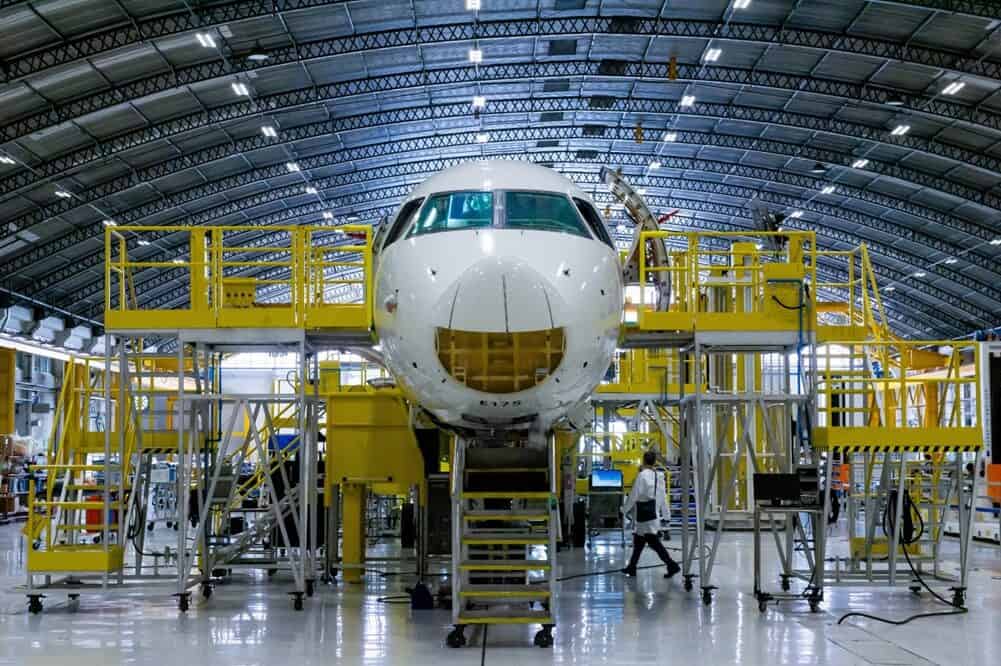
A successful flight
Since 2007, Embraer has adopted the Lean philosophy as a business strategy that disseminates its Business Excellence Program – P3E – fundamentals, concepts and practices. This program is responsible for generating transformations in an integrated manner, providing value for the entire company to improve its processes. The system aims at safety first, quality always, deliveries on time and at the best cost.
We talked to José Carlos D’Agostini Junior, Director of Operations at Embraer Commercial Aviation, about the benefits and results achieved by the company since the beginning of its Lean Transformation.

José Carlos D’Agostini Junior
Director of Operations
Embraer Commercial Aviation


Embraer has always been recognized as one of the Brazilian companies that has invested the most in Lean Thinking to manage its operations. The last three years were very challenging for Embraer and for the world market, which made the company bet even more on Lean concepts to improve its results and remain competitive. How did these challenges influence Embraer’s operations and what were the solutions found in Lean to overcome them?
In fact, Embraer has been navigating on Lean concepts for a long time. The Embraer Business Excellence Program, P3E, completed fifteen years in July and, during that time, has gone through different phases. More recently, we understood that we should go back to the origins and rescue the basic concepts of Lean Manufacturing. For this, it was necessary to be even more present at Genba, to rescue the fundamentals of Lean to be able to eliminate waste and make our processes more efficient, thus increasing the aggregation of value in our activities. In addition, we developed specific Excellence Manuals for the different areas of activity (Manufacturing, Product Engineering, Logistics, Quality, Services & Support, etc.) so that everyone could jointly apply Lean concepts in operational and administrative processes.
In the Manuals, we also define our Excellence System, starting with Embraer’s strategic planning, where the strategic map, its main objectives, KPIs and projects are defined. Strictly following the strategic map, we work to reduce the Lead Time of our products through Value Stream Mapping (VSM) by product. This is a way we use to map the entire flow, from closing the contract, to working with our suppliers, and final delivery of the aircraft. We were thus able to identify critical paths and the main sources of waste.
After this major mapping, we defined the target state and planned Kaizen projects. In this way, we were able to unfold, horizontally and vertically, the KPIs that are periodically monitored by leadership throughout the company. These same indicators are also broken down and monitored throughout the operation, through Shop Floor Management (SFM).
In summary, in my opinion, this use of VSM throughout the company allowed us to work with greater clarity on our Lead Times, from the supply chain to the delivery of the aircraft. This allowed us to act on critical paths and reduce our cycles, wait times and waste. This way, we were able to reduce our WIP and increase inventory turnover.

Embraer uses Shop Floor Management concepts to manage Embraer’s operations. Could you tell us a little bit about how the SFM was implemented in the company and what were the main benefits brought by this methodology in the day-to-day of the operation?
Shop Floor Management (or SQDC, as we call it at Embraer) is relatively new to us. We adopted this concept just over two years ago and have been evolving ever since. Its implementation followed the adoption of the strategic map, where we identified the need to permeate the strategic challenges throughout the operation. The first steps came with the definition of the KPI tree and the adoption of standardized KPIs throughout the operation. It was a co-creation process with the company’s leaders who sponsored the implementation. The next step was training all the leadership and other people involved, so that they understood the routines and purposes of the concept. The elaboration of standardized tables also played an important role in the construction of discipline and execution of routines.
Once these steps were completed, the routines began, assisted by P3E Lean consultants, who played a key role in guiding leaders and teams. The practice of Problem Solving with the recording of deviations/problems, correction actions, Go&See and the help escalation process was a challenge on its own, as it required a cultural change from teams and leaders.
After these few years of implementation, we can already see a clear change in the culture of problem solving and we are able to act more quickly and effectively on deviations. Another important benefit was the deployment and standardization of performance KPIs (Safety, Quality, Delivery and Cost), where everyone in the operation knows the company’s goals and, mainly, how its results are contributing to the company’s results. Another significant aspect is the approximation of the support areas to Genba, accelerating decision making and, thus, giving privilege to the Value Stream, since everyone who participates in the routines decides what is best for the Value Stream and not for their own departments only.

The Business Excellence Program (P3E), which brings together all of Embraer’s principles of Operational Excellence, was created in 2007 and has undergone several restructuring processes over the years. Could you tell us a little bit about the key moments of these reforms and what is expected of P3E for the next few years?
The Embraer Business Excellence Program (P3E) was created at a time when the company was going through a period of growth and expansion, with new products, expansion of its industrial operations, higher production rates and new markets.
In this scenario, the P3E was born based on four pillars: Culture, People, Processes and Leadership. In other words, we started very focused on developing a culture of transformation. For this, we strongly brought the concept of Kaizen, organizing projects into Kaizen Weeks, involving the entire leadership of the company. Added to this, we realized the need to structure the various processes in a standardized way, and we launched the continuous improvement cells, with their guides and standards, standardizing process and results management tools. With the advancement of our maturity, we evolved towards the grouping of continuous improvement cells, acting more in the Value Flows, connecting the company’s strategic indicators to the cell indicators.
Finally, our next step now is to intensify the focus on the Office areas with the implementation of Office Floor Management, bringing this same Lean efficiency throughout the organization.

In order to achieve results with Lean concepts, it is fundamental that the concepts and tools used are directly connected to the company’s strategy. How does Embraer do this today?
In defining the company’s strategic map, we have the Lean Philosophy as one of the fundamental pillars. So, from the beginning, we have considered this in the creation of our strategies. Today, in the Excellence System adopted by Embraer, we have 4 fundamental pillars:
- Understanding the Strategy
- Integrated Management
- Excellence in Process and
- People Protagonism
In Understanding the Strategy, we start from our strategic map, with its KPIs and Projects and, through Integrated Management, we put our VSM into practice and unfold the strategic KPIs for the Business Review of each vice president. In this part, monthly management is carried out, with deployment at all levels, from the Director to the teams in the Shop and Office Floor Management staff.
Excellence in Processes, on the other hand, is achieved through the creation and implementation of manuals dedicated to each area. This work is guided by the Lean consultant, and the area’s leadership is the main vector of transformation. To ensure People’s Protagonism, a massive training program called “Lean Academy” is linked to leaders and their teams so that they are prepared for the journey.
More than establishing what should be done, this entire implementation process is co-created between Lean leaders and consultants, defining an “Implementation Roadmap” with schedules and sequences by process/concept and periodic monitoring of progress. Finally, the “Lean Diagnosis” is carried out annually, where P3E consultants check adherence to Lean concepts and routines, process maturity and the results presented by the areas. With this diagnosis, leaders can easily identify opportunities for improvement in the implementation of concepts in the areas of their responsibility.
After these few years of implementation, we can already see a clear change in the culture of problem solving and we are able to act more quickly and effectively on deviations.”
JOSÉ CARLOS D’AGOSTINI JUNIOR
DIRECTOR OF OPERATIONS, EMBRAER COMMERCIAL AVIATION

Remaining on the topic of strategy and Embraer’s excellence system, how do you implement the initiatives and indicators for everyone in the company today, and how do you ensure that all levels are effectively engaged in these initiatives?
Embraer adopted the Excellence System based on its Strategic Planning, where the strategic map, main objectives, KPIs and projects are defined. Strictly following the strategic map, we have VSM by product, to track the entire value stream from our suppliers to the delivery of the aircraft, identifying critical paths and the main opportunities. After this major mapping, the KPIs are implemented, horizontally and vertically, throughout the company, and periodically monitored by leadership. In addition, these same KPIs are also implemented and monitored throughout the operation through Shop Floor Management.
Naturally, with the goals unfolded in the KPIs, the areas identify their challenges and opportunities, defining their improvement projects (Kaizens, 3P and good ideas) to achieve and sustain the proposed challenges.

Speaking of how to achieve better results with Lean principles, we know the importance of senior leadership involvement in a company’s Lean Transformation. What are the challenges to keeping all senior management engaged in transforming the company’s culture into a high performance Lean culture, going beyond the area of operations and reaching the company as a whole?
Embraer already has Lean leaders in its administration, which makes the whole process much more fluid. Top leadership is constantly present at Genba, not only in operations, but throughout the value stream processes, identifying opportunities, recognizing and encouraging improvement projects and challenging leadership to new achievements.
In addition, we have constant presence and sponsorship from senior management at Kaizen Weeks, Lean Transformation Week and at events to recognize the best projects of the year. Another important aspect is that we also maintain a specific training track for senior leadership at the Lean Academy, always keeping the present concepts and the desire for continuous improvement alive.
Magazine Article about Embraer
The lean transformation journey at Embraer
You might also be interested in

Alpargatas on the move
A global 115-year-old company, powered by iconics, on-trend brands, flip flop global leader to high potencial in footwear and lifestyle, Alpargatas is world known by one of its main brands: Havaianas.
Read more
Efficiency and sustainability in agribusiness
Louis Dreyfus Company invests in Brazil to meet the growing international demand for orange juice.
Read more
Transformation in the brazilian construction industry
Tenda is one of the main construction companies in Brazil, providing affordable housing to an increasing number of families investing in first-time home ownership. All projects are launched within the ‘Casa Verde e Amarela’ Government Program, aimed at families with a gross monthly income of up to R$4,000.
Read more

